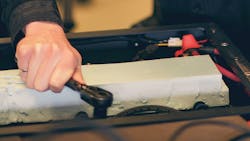This file type includes high resolution graphics and schematics when applicable.
Automated guided vehicles (AGVs) and carts (AGCs) provide a more flexible system than conventional conveyor belts for many applications. Still, the current crop of AGV/AGC systems has limitations. On that front, Clearpath Robotics introduced its OTTO 1500 at Robobusiness 2015 (see “RoboBusiness 2015: A Sneak Peek”).
I talked with Ryan Gariepy, CTO and Co-Founder of Clearpath Robotics, about the firm’s latest driverless solution, as well as overall market trends within the robotics community.
Wong: What are some trends you’re seeing in the unmanned vehicle and robotics industries?
Gariepy: Industry in general is accepting unmanned vehicles as a legitimate solution to very complex problems, and operators are beginning to see that self-driving vehicles can, in some cases, solve problems that we didn’t know we had.
Within manufacturing, the marketplace is demanding customization of products, whether it’s ordering the green iPod instead of the blue one, or putting heated seats in your new car instead of a sunroof. Consumers demand more choice, which leads to skew proliferation, which leads to the need for more flexible automated solutions on the warehouse floor.
Wong: Statistics show that the applications of robotics are rising and diversifying within various industries. Is this something you’ve witnessed at Clearpath Robotics?
Gariepy: Yes, definitely. Since Clearpath’s inception, we have seen industrial robotics transform from simple, automated guided carts traversing factories, to smaller more flexible pieces of automation that are purpose-built for process rather than product. We’re also seeing a rising need for robots that can work side-by-side with factory workers, rather than traditional warehouse robots that work in a dedicated cell.
Wong: What’s the vision behind Clearpath Robotics?
Gariepy: In our early years, we became a global leader of unmanned vehicles for research and development. Now we want to leverage that expertise and experience to become a global leader in self-driving vehicles for industry.
Wong: Why did you choose to showcase your newest products at RoboBusiness 2015? What is the significance of the conference?
Gariepy: RoboBusiness has a strong mix of business leaders and technologists. Moreover, the attendees tend to be decision makers; these are the people we want to showcase our latest and greatest to. RoboBusiness is also one of the only events that we’ve seen at this time of year that attracts industrial operators seeking new innovations to add to their roster in the new fiscal year.
Wong: Where is the market demand for Clearpath’s new solution? What advantages are provided by this new solution?
Gariepy: Traditional automated solutions, such as AGVs, AGCs, and conveyors, are typically not flexible enough for today's lean-focused operations. These solutions often cause inefficiencies and bottlenecks. When designing OTTO 1500, Clearpath embraced challenges associated with traditional materials handling. We didn’t engineer a solution to push onto the market. Rather, we designed OTTO 1500 to meet market demands; those demands are coming from materials-handling operators who want a more flexible and scalable autonomous solution that will increase throughput, decrease operational costs, and work side-by-side with humans.
Clearpath is able to offer these advantages because OTTO 1500 is designed to operate with infrastructure-free navigation. In addition, the safety-certified LIDAR on the front and rear of the vehicle works with the perceptive LED display to safely communicate its intended actions to floor workers.
Wong: How do customers benefit from Clearpath’s solutions?
Gariepy: Our products are ruggedized for industry and designed with the customer, and the use case, in mind. Therefore, customers benefit from high-quality, durable solutions that address their challenges. As such, customers are able to reap the benefits of flexible payloads, scalable solutions, and a higher return on their investment.
Wong: How are Clearpath Robotics’ products different from other robotics solutions on the market?
Gariepy: At the moment, there isn’t anything that can match the offering of OTTO 1500. We’ve designed a self-driving vehicle for industry that has a unique combination of safety and performance, and the fact that it can be integrated into operations with infrastructure-free capability (for instance, no tape, cables, or barcodes) is a game changer.
About the Author
William G. Wong
Senior Content Director - Electronic Design and Microwaves & RF
I am Editor of Electronic Design focusing on embedded, software, and systems. As Senior Content Director, I also manage Microwaves & RF and I work with a great team of editors to provide engineers, programmers, developers and technical managers with interesting and useful articles and videos on a regular basis. Check out our free newsletters to see the latest content.
You can send press releases for new products for possible coverage on the website. I am also interested in receiving contributed articles for publishing on our website. Use our template and send to me along with a signed release form.
Check out my blog, AltEmbedded on Electronic Design, as well as his latest articles on this site that are listed below.
You can visit my social media via these links:
- AltEmbedded on Electronic Design
- Bill Wong on Facebook
- @AltEmbedded on Twitter
- Bill Wong on LinkedIn
I earned a Bachelor of Electrical Engineering at the Georgia Institute of Technology and a Masters in Computer Science from Rutgers University. I still do a bit of programming using everything from C and C++ to Rust and Ada/SPARK. I do a bit of PHP programming for Drupal websites. I have posted a few Drupal modules.
I still get a hand on software and electronic hardware. Some of this can be found on our Kit Close-Up video series. You can also see me on many of our TechXchange Talk videos. I am interested in a range of projects from robotics to artificial intelligence.




